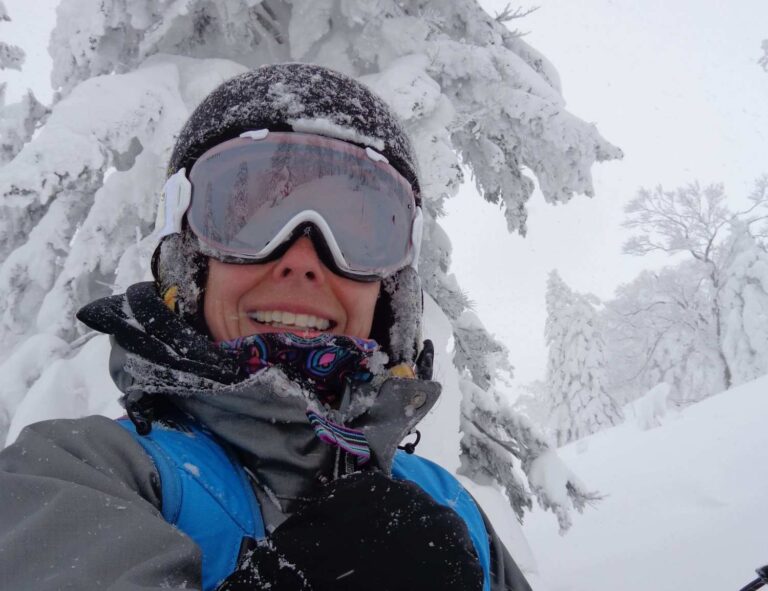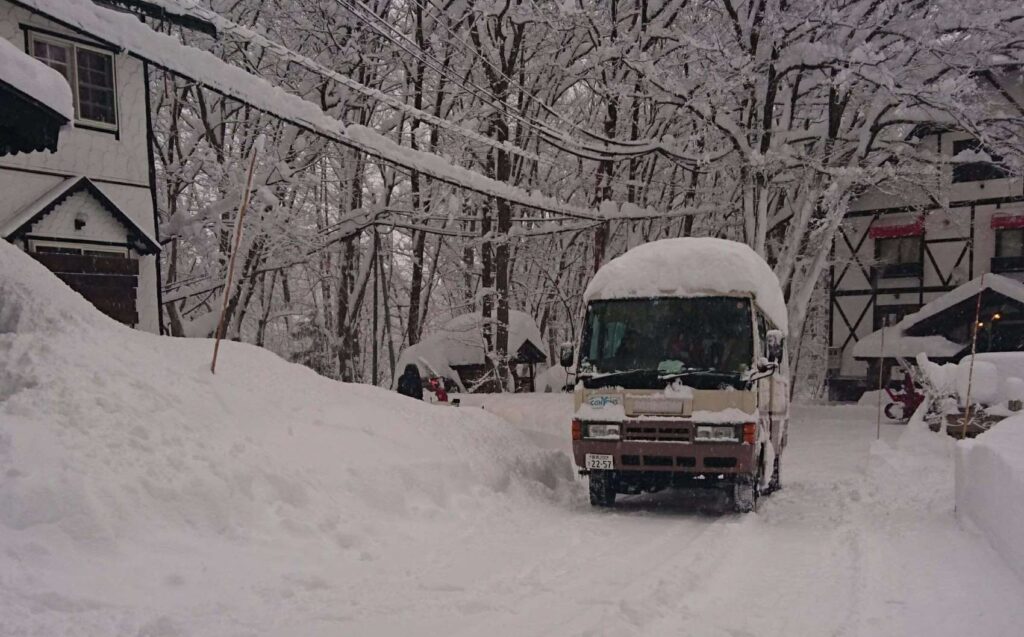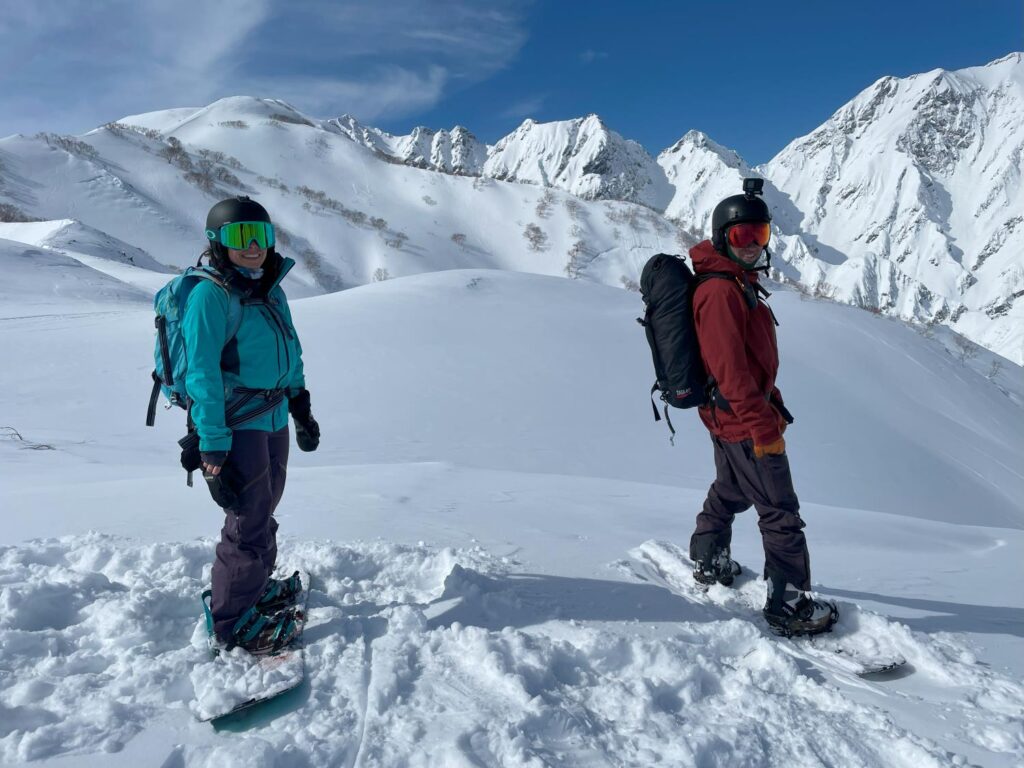What To Pack For A Ski Or Snowboard Trip
Packing the right gear for your ski or snowboard trip to Japan is a crucial part of the Japow adventure process. What should you wear? Will you bee too cold? Too hot? It’d be easy to say “Just take everything!” but with strict luggage allowances and ease of navigation through public transport hubs, this isn’t the best option. Here, we will help you figure out what’s important, and what might be best to leave behind when packing for a skiing or snowboarding trip to Hakuba.
What to wear skiing or snowboarding in Hakuba
The temperatures in Hakuba average between 3° / -7° Celsius. Some days, with wind chill, it can get extremely cold, but for the most part the harshness of the temperatures are nothing to write home about. Although the temperatures are technically colder than New Zealand or Australian ski temps, I find that I wear the exact same amount of layers, with the odd windy day requiring an additional layer. The difference in humidity means it doesn’t feel so cold despite the difference in temperature.
The major consideration with what to wear skiing or snowboarding in Hakuba, is how your clothing deals with deep powder. A onesie or bib pants/overalls is a very good idea if you’re not so keen on getting a butt-crack full of snow (which in turn, melts to water and you feel like you’ve wet your pants!). A powder skirt is a common feature on jackets, although, i’ve never had one that works particularly well. Another trouble area is where the gloves meet the arms of your jacket. Seal it up to ensure your hands and arms stay dry and warm.
Finally, the face cover. If you’re doing it right, you’ll be dealing with face shots on a regular basis. Cold snow blasting to the face on an already cold day is a recipe for terrible discomfort. Find a face mask that works for you. On a regular day I am happy with a buff that I pull up over my nose. On a big powder day, I will opt for a more sturdy face-mask with holes at the nostrils for a good air flow. Everyone seems to like something different here, but at the very least, make sure you own a buff.
On a regular day snowboarding I will wear:
- 1 merino base layer top and bottom thermal
- 1 pair of good quality merino, below the knee socks
- Waterproof bib-pants with straps over the shoulders (or normal ski pants)
- 1 mid layer (depending on the weather, this might be a thick woollen sweater or a light merino layer)
- Waterproof and insulated ski jacket (sometimes I opt instead for a waterproof shell jacket with a super warm puffer jacket underneath as my mid-layer… a good option if you are indecisive)
- Helmet
- Good quality gloves and goggles
- Face-mask

What to wear in the village after a day on the snow
Boots. Snow specific walking boots if you can. There is no need to bring your vans or other casual shoes to Hakuba during the colder months as you will literally want to wear your snowboots everywhere (please don’t confuse this with ski or snowboard boots. Thats not what I mean. I’m talking sorrell typed boots with tread in the sole and high clearance above the ankle). Most roads and footpaths will be covered in snow and ice most of the time making it very slippery and cold. It is acceptable to wear your snowboots into all resturants and bars, with the exception of certain traditional restaurants where you’d have to remove your shoes anyway. I’d almost say that there could be more injuries caused in Hakuba for people slipping over in the village than there are on the ski hill… Moral of the story – bring suitable footwear.
To decide the rest of your outfit, look to what you normally wear in winter, then add your ski jacket, warm hat and some small woolen gloves. Jeans, tee and sweater will see you right indoors. The rest will keep you warm when walking between places. Depending on how long you are staying, and how fashion consious you are… you probably only need one or two outfits for the evenings. Save your luggage allowance for snow gear.
Should I bring my ski/snowboard gear? or rent gear in Hakuba?
The answer to this will be different depending on your situation…
When to bring your own gear:
- You have awesome gear of your own that you really want to use.
- You have a luggage allowance that lets you bring oversized baggage.
- You would rather lugg your gear around in order to save money. (see this post on affordable luggage delivery services to remove this problem).
- You don’t want to spend time during your trip organising rental gear, or risking that they don’t have what you want.
When to rent ski and snowboard gear:
- You don’t have your own, or if you do, it’s not that great.
- Your luggage allowance doesn’t let you bring oversized baggage (or you’d prefer not to risk it).
- You’d rather travel with minimal luggage at the cost of renting.
- You like the idea of having the flexibility to change your gear to suit the conditions. Most rental places will let you exchange your gear once each day if you’d like.
What type of luggage should I use?
This will depend on whether you are bringing all your toys or not. If you are renting snow gear when you arrive at Hakuba, a large suitcase with wheels is a good option. It’s also worth thinking about how waterproof/durable your case is because you never know when you will encounter an un-groomed footpath with a foot of fresh snow to battle through. This doesn’t happen often, but trust me, it does happen.

Wheelie bags are great in train stations (there is always an option to take the lift if you cant carry your bag up stairs), and fits nicely in most vehicles. You might also choose to take a large travel backpack if you’d prefer not to have wheels.
If you are bringing all your ski/snowboard gear with you, make sure you have wheels on your bag! Walking through train stations with a large, heavy, non-wheelie bag gets old VERY fast. Of course, there is always the option of sending your bags, but if you don’t have the time to allow for this service, for Pete’s sake, get some wheels! Your hands will thank you for it later.
When doing a winter snow trip I will always take my 150cm snowboard bag with wheels as my main luggage item and a medium sized backpack for carry on. The backpack doubles as a day pack for sightseeing or doing back-country missions. Usually I fill the snowboard bag up with as much as I can, mostly riding gear (keeping within the airline weight allowance) then fill the backpack up mostly with clothing. It’s usually right on the verge of going over the allowance, but so far, has worked every time. Always weigh your bags before heading to the airport.
Packing Checklist for a Ski or Snowboard trip to Hakuba
A day on the slopes:
- Merino/wool socks x2
- Base layer pants x2
- Snow pants (bib pants or onesie if you have them)
- Base layer top x2
- Tee-shirt (optional)
- Mid layer such as a hoodie, or thin puffer jacket
- Snow jacket (must be water and wind resistant)
- Gloves (warm and waterproof – opt for gortex if possible)
- Face-mask (trust me, you’ll want something to protect your face from all that snow you’ll be sending up)
- Goggles (It’s best to have both low and high light lenses, but an all-round lens generally does the trick in Hakuba)
- Helmet
Village/travel clothes:
- Snow-boots (good tread, deigned for walking, above the ankle)
- Jeans/pants
- Top/tee-shirt x2
- Sweater (could also be one of your snow mid-layers if necessary)
- Woollen gloves
- Warm hat/beanie
- Underwear
- Trackies (optional)
Miscellaneous items:
- Toiletries
- Sunglasses
- Phone charger
- Plug adaptor
- Flip flops/thongs/jandals (because you shouldn’t go anywhere without your jandals!)
Snowboard gear:
- Snowboard
- Snowboard boots
- Snowboard bindings
- Screwdriver (optional)
Ski gear:
- Skis
- Ski boots
- Poles
Split-board/ski touring gear:
- Skins
- Telescopic poles
- Backpack
- Transceiver
- Shovel
- Probe
- Tool/army knife
- First aid kit
- Sun hat
- Light shell jacket


